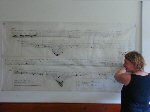While the recording methods of most modern excavations now include some aspect of digital recording from which publication drawings might be easily derived (data that is "born digital"; Richards and Robinson 2000), the illustrative material from excavations at Cricklade, Wiltshire (Haslam 2003) were submitted to Internet Archaeology as a series of 12 large format, ink-on-permatrace drawings, some in excess of 1.5 metres in length (Figure 1).
These plans and sections had been drawn with the intention of reducing their scale and being incorporated into a paper publication. This never happened and so the only (printed) report of the excavations sat on the shelves of an archive and, by and large, remained inaccessible to interested parties, not least because no-one really knew of its existence. Some 25 years after the excavations, the excavator, Jeremy Haslam, turned to Internet Archaeology, since the large size of the report and its accompanying images was felt to have little prospect of full publication in any other form. Although the size of the report was not a great issue for Internet Archaeology, converting the large images to a format for inclusion in the journal did present something of a challenge at both a logistical and conceptual level.

Figure 1: One of the 12 large, ink-on-permatrace section drawings (with Judith Winters for scale!).
The potential benefits of digital image publication over traditional publication, such as the use of colour and the introduction of interactivity, are well documented (Heyworth et al. 1995, Livingood 1996, Heyworth et al. 1997), but little work has been undertaken regarding the retrospective publication of non-digital images in a digital format.
The permatrace drawings from Cricklade that were submitted to the journal represented the only drawn record of the 1975 excavations so had to be digitised in order to be included in the final publication. The methodology presented here developed out of this preparatory work. The publication was funded by English Heritage and was, in part, an experiment designed to explore some of the possibilities presented by digital image publication, but it also had the additional aim of exploring the feasibility of this approach for future journal articles (Winters 2002, email communication).
The publication of large plans, maps and section drawings has always been a problem in archaeological publishing, for both print and electronic publication. In print, the costly fold-out became one solution but used only in the most prestigious publications. Although space is less of a consideration for digital publications, the effective online presentation of large images has still relied on a combination of inter-linked thumbnails, large scale and more detailed (separate) images. Raster images (static JPEG and GIF files) are very much the norm but often require significant manipulation to create a 'zoom' effect at the user end and are usually difficult to modify without loss of information (although software tools are now becoming available that can convert raster files into a vector file for refinement and changes).
The large Cricklade plans and sections, however, forced a rethink of how to incorporate such material effectively into a journal article and the funding of the publication enabled the opportunity to explore some of these possibilities.
Several options were proposed at the article planning stage (Winters 2001, email communication), and it was agreed that Internet Archaeology would undertake to digitise important segments of the large sections as vector graphics (which would be scaled without loss of image resolution) and link them from the static summary phase section drawings. It was felt this approach provided a suitable enhanced level of detail and allowed for some real innovation in how the sections are viewed by the user. Once the nature of the work to be undertaken was established, Guy Hopkinson had the task of turning the ideas into reality.
© Internet Archaeology
URL: http://intarch.ac.uk/journal/issue14/5/intro.html
Last updated: Tue Feb 3 2004